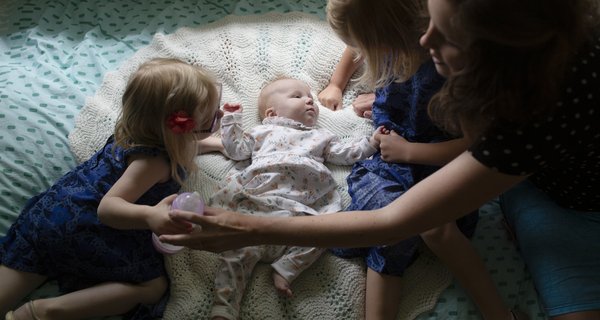This research, commissioned by Nesta and carried out by Alma Economics, provides a comprehensive analysis of public spending on early years support in England.
This report analyses public sector spending on children aged 0-4 across government departments, including welfare, health, education (childcare) and children’s services and social care. The report looks at how the level, composition and distribution of spend has changed between 2010/11 and 2022/23, the latest year all these data were available.
Nesta is commissioning similar research for early years spending in both Wales and Scotland.
What’s in the report
This research, commissioned by Nesta and carried out by Alma Economics, provides a comprehensive analysis of public spending on early years support in England, including:
- trends in the level and composition of spending over time
- analysis that is structured around the four broad areas of welfare, healthcare, children’s services and social care, and free childcare entitlement
- disaggregation of results across children growing up in higher and lower income families, and by beneficiary age.
Findings

Total early years spending in England, current prices
Image Description
Stacked bar chart titled "Total early years spending in England, current prices", displaying spending categories from 2010/11 to 2022/23. The spending categories are colour-coded:
- Blue for Healthcare
- Purple for Childcare
- Red for Children's services and social care
- Yellow for Welfare
The vertical axis represents spending amounts (in thousands), while the horizontal axis shows the financial years. The chart reveals that Welfare consistently makes up the largest portion of spending, followed by Children's services and social care, Childcare, and Healthcare. The total spending appears relatively stable over the years, with minor fluctuations.
- Welfare spending (yellow) makes up the largest share throughout the period but declines proportionally over time. Its height shrinks slightly in comparison to the other categories, indicating that its share of total spending is decreasing.
- Childcare (purple) and Children’s services and social care (red) both increase proportionally.
- Healthcare (blue) appears relatively stable in its share, maintaining a consistent proportion of the total spending.
Overall, while the total spending stays relatively flat, the composition shifts – less towards welfare and more towards childcare and social care.
- We estimate that public spending on children aged 0-4 in England amounted to £6,400 per child on average, or £21bn in total, in 2022/23. The largest broad area of early years spending is welfare, at just under £3,000 per child in 2022/23 (£9bn per year), or 46% of the total.
- Stability in the total, but a big shift in the composition of this spending. The total level of early years spending per child in England has fluctuated slightly from year to year but overall has changed little in real terms since 2010/11, when it was £6,600 per child. However, this masks the offsetting effects of large spending changes in different areas. Welfare spending on children aged 0-4 has reduced by £1,000 per child, and spending on children’s services and social care has fallen by £300 per child. Meanwhile, spending on free childcare and healthcare has, in combination, almost doubled, from £1,400 per child to £2,600 per child. The share of early years spending on welfare has fallen from 60% in 2010/11 to 46% in 2022/23. Free childcare has grown greatly in importance. It overtook healthcare and children’s services and social care during the early 2010s to become the second-largest source of spending on children aged 0-4, and it is being expanded further during the current financial year.
- There are clear links to policy choices. Falls in welfare spending are the consequence of large cuts to the generosity of many benefits and tax credits during the austerity of the 2010s. These cuts have affected all working-age families in receipt of benefits and were not explicitly targeted at the early years, though a number of them were targeted specifically at families with children. The reduction in spending on children’s services and social care is entirely driven by a fall of about 75% in Sure Start spending (equating to a cut of about £400 per child), which reflects decisions to withdraw most funding for Sure Start centres in England during the 2010s. With this change, the system of support via children’s services and social care has shifted in emphasis towards post hoc responses to high needs – with Children Looked After now the single largest item of spending in this area – and away from the kind of preventative early intervention that many of the Sure Start services were focused on. Meanwhile, the rise of free childcare spending results from deliberate large expansions of entitlements to free childcare hours. The rise in early years healthcare spending does not, to our knowledge, have a clear link to explicit policy decisions, and would be worthy of further research.
- Distributional implications. Although total early years spending has changed little, this stability is unlikely to reflect the experience of all groups due to the large shifts in the composition of spending. It is highly likely that early years spending has been distributed less towards lower-income households overall since 2010/11. Welfare is by far the most progressive of the spending areas, but it is where most of the cuts to early years spending have fallen. Similarly, Sure Start was highly targeted at poorer areas, and cuts to Sure Start explain all of the cut in spending on children’s services and social care. Conversely, free childcare, which has been the major rising area of early years spending, is distributed much more evenly across income groups: at least half of the free entitlements are used by families in the top half of the income distribution. Similarly, healthcare spending is distributed primarily to lower-income households and has been increasing since 2010/11.





